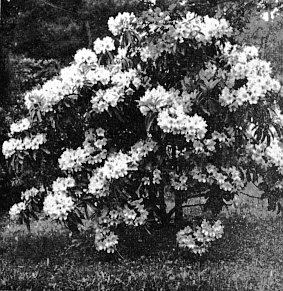QBARS - v17n4 Rudolph Henny's Breeding Objectives and Attainments
Rudolph Henny's Breeding Objectives and Attainments
Cecil Smith, Aurora, Ore.

|
|
Fig. 37. A well-proportioned plant of
'Dondis' in the garden of Rudolph Henny who used this variety as a parent in producing several of his introductions. |
These notes are based on my recollections of many happy hours spent with Rudolph in talking about crossing rhododendrons. Also Mrs. Henny kindly loaned me his record book of crosses in which he had written down comments on different plants as they bloomed through the years.
It takes many years for a rhododendron to become well known. The 'C.I.S.' cross, for instance, was made in 1944 and now, almost twenty years later, is becoming readily available.
Most of us, when we bloom something that we think is pretty good, get a wild desire to name it and try for an award. Rudolph generally waited until the majority of a cross had bloomed and then watched them and made notes for several years before deciding on their worth. A typical note in his record book reads, " 'Confection' drew favorable comment in garden for 3 or 4 years before being shown for an award."
In the great majority of crosses Rudolph tried to get plants which would be hardy in the Northwest rhododendron belt. The most of his better known crosses were made prior to 1949 and so lived through that severe winter and the sharp early freeze of 1956. Comments on their behavior in these years are found throughout his record book.
Another aim was to produce a hybrid with distinctive blooms. Here, where cast iron hardiness is not of prime consideration, it is not too difficult to get a plant with a nice bloom, but to get something really different is much harder to attain when you consider the tens of thousands of rhododendrons listed in the 'International Rhododendron Register.' Rudolph's most widely known distinctive cross is 'C.I.S.', and there are others which I believe, will in time become known as fine and distinctive hybrids.
Rudolph favored a campanulate shaped corolla which could range from cup shaped to saucer shaped. If the truss were sparsely flowered and lax, he wanted the plant to bloom profusely so that it would be nearly covered with hanging bells. In the last half of April and early May his garden was full of plants with this type of inflorescence, varying widely in color and size of plant.
In reds he tried to get away from any bluish tinge. 'Captain Jack', 'Red Cloud' and 'Dr. Ross' are some reds that approach that goal.
When we think of yellow most of us visualize daffodil yellow, which has some orange in it. Some forms of R. wardii and R. campylocarpum approach pure yellow. Rudolph often said that the daffodil yellow rhododendron would have R. dichroanthum in its ancestry, and he made many crosses with the species and with 'Fabia.' There are many fine things from these crosses, but the elusive daffodil yellow is not evenly spread throughout the corolla. He finally flowered a yellow with a touch of orange in it and with the color uniform over the corolla. He called it 'Gold Strike,' a Cinnabarinum series cross.
In the Henny garden there are a number of closely set groups of unnamed seedlings with fine inflorescences which Rudolph considered lacked either good plant habits or good foliage characteristics. I would not attempt to estimate the number of hundreds of plants he bloomed and rejected for everyone he named.
To create that hybrid with fine foliage, good plant habit, hardiness, and a shapely truss of flowers that is really distinctive takes either luck, or much more likely, the growing of many hundreds or thousands of seedlings to flowering age.
